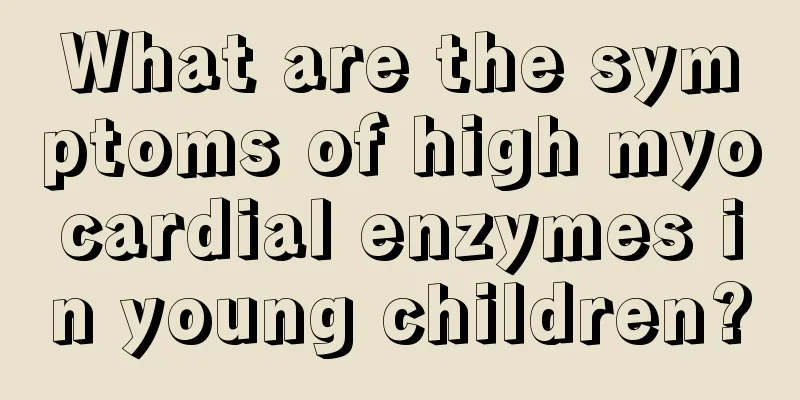What are the symptoms of high myocardial enzymes in young children?

|
When taking biology or chemistry classes, people will come into contact with a substance called enzyme. Especially in chemistry, enzymes can exist as a catalyst. In the human body, the role of enzymes is also very important. There is a substance called myocardial enzyme in the myocardium. When some children undergo physical examinations, it is found that their myocardial enzyme levels are high. So, what are the symptoms of high myocardial enzymes in young children? Myocardial enzyme is a relatively specific protein present in the blood. It mostly comes from myocardial cells. It is not high under normal circumstances. When there is a myocardial lesion, it can be secreted into the blood, thereby increasing the level of the enzyme being examined. The corresponding clinical symptoms of high myocardial enzymes mainly include chest pain, palpitations, dyspnea, etc. In addition, what are the other symptoms of high myocardial enzymes? High myocardial enzymes are likely to be myocarditis, but it cannot be confirmed yet, and the doctor also needs relevant physical examination signs. In addition to these, electrocardiogram evidence is also needed, such as manifestations of myocardial damage and arrhythmias. If conditions permit, a cardiac ultrasound can also be performed to check the heart size and heart function. If it is determined that myocardial enzymes are high, it is myocarditis. Then, for myocarditis caused by infectious reasons, there are often symptoms of primary infection first. For example, viral ones often have fever, sore throat, cough, vomiting, diarrhea, muscle aches, etc. Most of the symptoms of myocarditis appear 1 to 3 weeks after the viral infection. Regardless of the cause of myocarditis, the clinical symptoms of myocarditis are related to the characteristics of myocardial damage. For example, patients with arrhythmia as the main manifestation may experience palpitations, and severe cases may have blackouts and syncope; patients with heart failure as the main manifestation may experience various symptoms of heart failure such as dyspnea; severe cases may develop cardiogenic shock and related manifestations of shock; if the inflammation involves the pericardium and pleura, symptoms of chest tightness and chest pain may occur; some patients may also have manifestations similar to angina pectoris. Common physical signs include sinus tachycardia that is not parallel to body temperature, sinus bradycardia and various arrhythmias may also occur. Heart border enlargement accounts for 1/3 to 1/2 of patients, which is seen in severe myocarditis. Heart enlargement can cause mitral or tricuspid valve regurgitation, systolic murmur at the apex or left lower edge of the sternum, diastolic gallop rhythm and weakened first heart sound may be heard in patients with severe myocardial damage or heart failure, pericardial friction sound may be heard in patients with pericarditis, and mild cases may be completely asymptomatic and sudden death may occur. Although children's myocardial enzyme levels are higher than adults, there is a range. If it exceeds the range, parents need to be vigilant. So, if a child's myocardial enzyme is high, what symptoms will occur? Elevated myocardial enzymes are common in myocarditis and acute myocardial infarction. Myocarditis is a diffuse or localized inflammation of the myocardium. The symptoms are related to the degree and area of myocardial damage, and the severity varies. In mild cases, there are almost no symptoms. Fever, body aches, sore throat, diarrhea, etc. are often prodromal symptoms. Symptoms of myocarditis are: chest tightness, dull pain in the precordial area, palpitations, fatigue, nausea, dizziness, fainting, etc.; severe cases may lead to sudden death, or transformation into cardiomyopathy and heart failure. However, it should be noted that the diagnosis of myocarditis is not based solely on myocardial enzymes, but also requires corresponding clinical symptoms, such as chest pain, palpitations, dyspnea, etc., and the doctor also needs relevant physical examination signs. In addition to these, electrocardiogram evidence is also required, such as manifestations of myocardial damage and arrhythmias, etc. If conditions permit, cardiac ultrasound can also be performed to check heart size and heart function. If you have symptoms now, it is best to receive symptomatic treatment immediately and the condition cannot be delayed. |
<<: What are the early symptoms of myocarditis in children?
>>: What are the early symptoms of myocarditis in children?
Recommend
Treatment of eczema in children
Eczema is a common skin problem. People of all ag...
What is the reason for the baby's lung noise when coughing?
The physical health of the baby during the growth...
What should children eat to improve their memory?
Today's only children are the apple of their ...
Introduction to the time and precautions of pediatric massage
Babies themselves do not know how to exercise and...
Why do babies always fart?
Everyone knows that farting is a very normal beha...
What are the white spots on the baby's neck?
Babies have weak physical conditions and their im...
Treatment for diarrhea in children
The problem of diarrhea is the problem of constip...
Traditional Chinese Medicine Treatment of Otitis Media in Children
Otitis media, especially acute suppurative otitis...
What's wrong with the white skin on the child's leg?
Children in their early childhood are very prone ...
18-month-old baby's intellectual development
During the baby's growth and development proc...
What should children eat when they have stomachache?
What should children eat when they have stomachac...
Why does my child have bloating and pain on both sides of his abdomen?
With the accelerated pace of life and the improve...
How to train children's memory?
Memory is the foundation of learning, especially ...
What should I do if my child has a fever recently?
Parents must not panic when their children have a...
Causes of watery diarrhea in babies
Many parents are particularly concerned about the...









